Determining Employment Status and Tax Deductions in Law
VerifiedAdded on 2021/04/16
|8
|2046
|84
Homework Assignment
AI Summary
This assignment delves into employment law, specifically focusing on the distinction between independent contractors and employees. It analyzes the legal criteria used to determine employment status, referencing key cases like TNT Worldwide Express (NZ) v Cunningham and Bryson v Three Foot Six Limited, and applying tests such as control, integration, intention, independence, and economic reality. The assignment then examines the tax implications of each employment status, including PAYE deductions, GST registration, and ACC levies. It also explores various income types and allowable deductions under the Income Tax Act 2007, providing examples and citing relevant legislation and case law such as CIR v Banks, Mallalieu v Drummond, and Mitsubishi Motors v CIR. The analysis covers exempt income, taxable income, and deductible expenses, offering a comprehensive overview of employment law and tax considerations for both employees and independent contractors.

Question 1
Answer A
Issue
The issue in this case is to identify whether William is an independent contractor or an employee
Theory
One of the primary cases in relation to determining whetherthe relationship of a person with a
business is that of an employer or an independent contractor has been provided through the case
of TNT Worldwide Express (NZ) v Cunningham, (1933). In this case whether the person has
entered into a contract of service or a contract for service was determined by the court. Here the
court had to analyze whether the plaintiff driver was an employee or an independent contractor.
It was ruled by the court after analysis that the driver was an independent contractor. Another
significant case where the issue has been discussed is the case ofBryson v Three Foot Six
Limited, (2005).In this case it was stated by the court that along with the real nature of the
relationship all relevant matters were taken into consideration to determine the issue. The factors
which were considered in this case were oral and written contract terms, real behavior in contract
implementation, control and integration, economic reality and industry practice. There are five
tests which are used by the courts for the purpose of determining whether a person is an
employee or an independent contractor (Kiely, 2011). These are control, independence,
integration, intention and economic reality test.
According to Section YA1 of the Income Tax Act 2007, an employee is a person who is entitled
to or actually receives PAYE income payment. The term employee does not include a person
Answer A
Issue
The issue in this case is to identify whether William is an independent contractor or an employee
Theory
One of the primary cases in relation to determining whetherthe relationship of a person with a
business is that of an employer or an independent contractor has been provided through the case
of TNT Worldwide Express (NZ) v Cunningham, (1933). In this case whether the person has
entered into a contract of service or a contract for service was determined by the court. Here the
court had to analyze whether the plaintiff driver was an employee or an independent contractor.
It was ruled by the court after analysis that the driver was an independent contractor. Another
significant case where the issue has been discussed is the case ofBryson v Three Foot Six
Limited, (2005).In this case it was stated by the court that along with the real nature of the
relationship all relevant matters were taken into consideration to determine the issue. The factors
which were considered in this case were oral and written contract terms, real behavior in contract
implementation, control and integration, economic reality and industry practice. There are five
tests which are used by the courts for the purpose of determining whether a person is an
employee or an independent contractor (Kiely, 2011). These are control, independence,
integration, intention and economic reality test.
According to Section YA1 of the Income Tax Act 2007, an employee is a person who is entitled
to or actually receives PAYE income payment. The term employee does not include a person
Paraphrase This Document
Need a fresh take? Get an instant paraphrase of this document with our AI Paraphraser
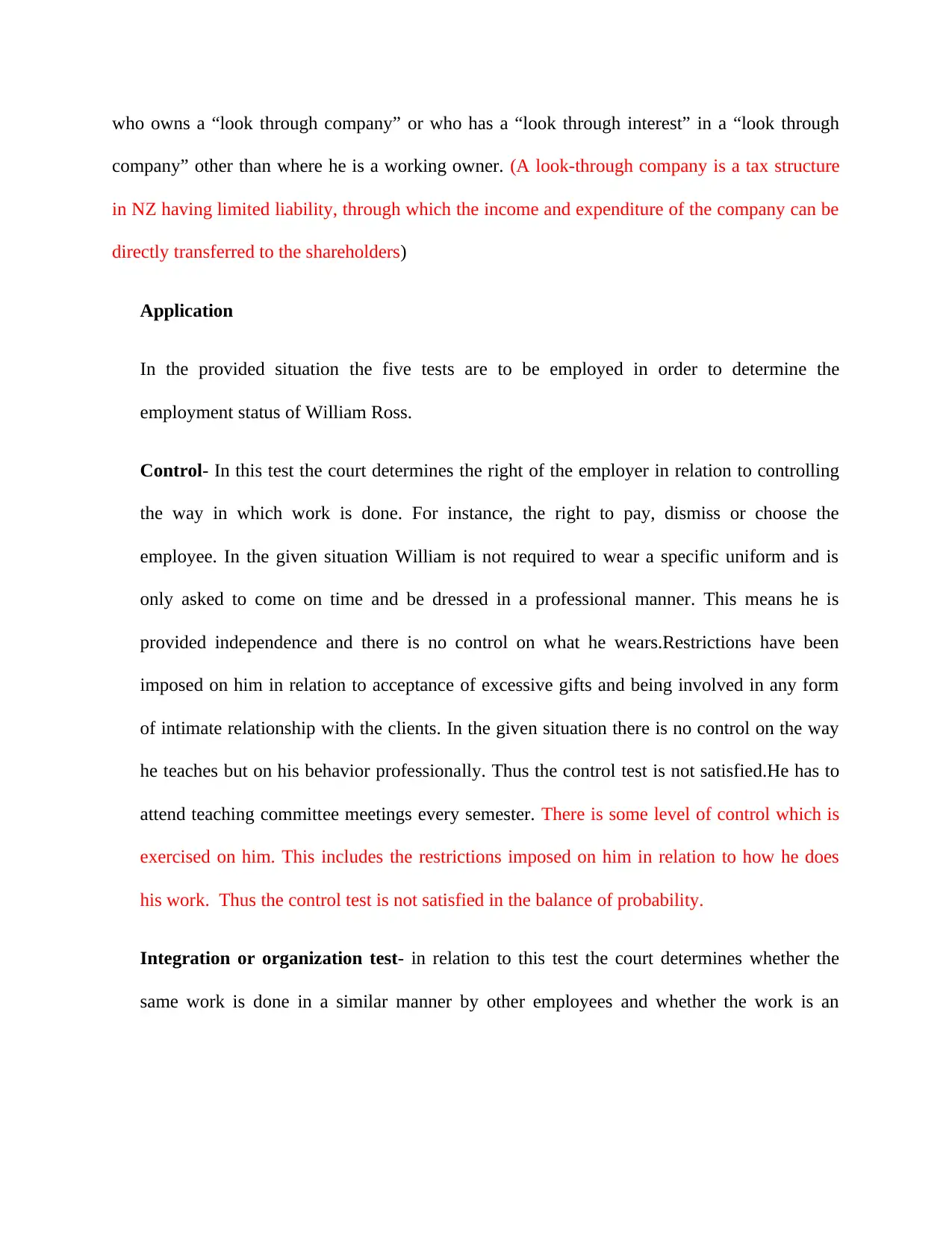
who owns a “look through company” or who has a “look through interest” in a “look through
company” other than where he is a working owner. (A look-through company is a tax structure
in NZ having limited liability, through which the income and expenditure of the company can be
directly transferred to the shareholders)
Application
In the provided situation the five tests are to be employed in order to determine the
employment status of William Ross.
Control- In this test the court determines the right of the employer in relation to controlling
the way in which work is done. For instance, the right to pay, dismiss or choose the
employee. In the given situation William is not required to wear a specific uniform and is
only asked to come on time and be dressed in a professional manner. This means he is
provided independence and there is no control on what he wears.Restrictions have been
imposed on him in relation to acceptance of excessive gifts and being involved in any form
of intimate relationship with the clients. In the given situation there is no control on the way
he teaches but on his behavior professionally. Thus the control test is not satisfied.He has to
attend teaching committee meetings every semester. There is some level of control which is
exercised on him. This includes the restrictions imposed on him in relation to how he does
his work. Thus the control test is not satisfied in the balance of probability.
Integration or organization test- in relation to this test the court determines whether the
same work is done in a similar manner by other employees and whether the work is an
company” other than where he is a working owner. (A look-through company is a tax structure
in NZ having limited liability, through which the income and expenditure of the company can be
directly transferred to the shareholders)
Application
In the provided situation the five tests are to be employed in order to determine the
employment status of William Ross.
Control- In this test the court determines the right of the employer in relation to controlling
the way in which work is done. For instance, the right to pay, dismiss or choose the
employee. In the given situation William is not required to wear a specific uniform and is
only asked to come on time and be dressed in a professional manner. This means he is
provided independence and there is no control on what he wears.Restrictions have been
imposed on him in relation to acceptance of excessive gifts and being involved in any form
of intimate relationship with the clients. In the given situation there is no control on the way
he teaches but on his behavior professionally. Thus the control test is not satisfied.He has to
attend teaching committee meetings every semester. There is some level of control which is
exercised on him. This includes the restrictions imposed on him in relation to how he does
his work. Thus the control test is not satisfied in the balance of probability.
Integration or organization test- in relation to this test the court determines whether the
same work is done in a similar manner by other employees and whether the work is an
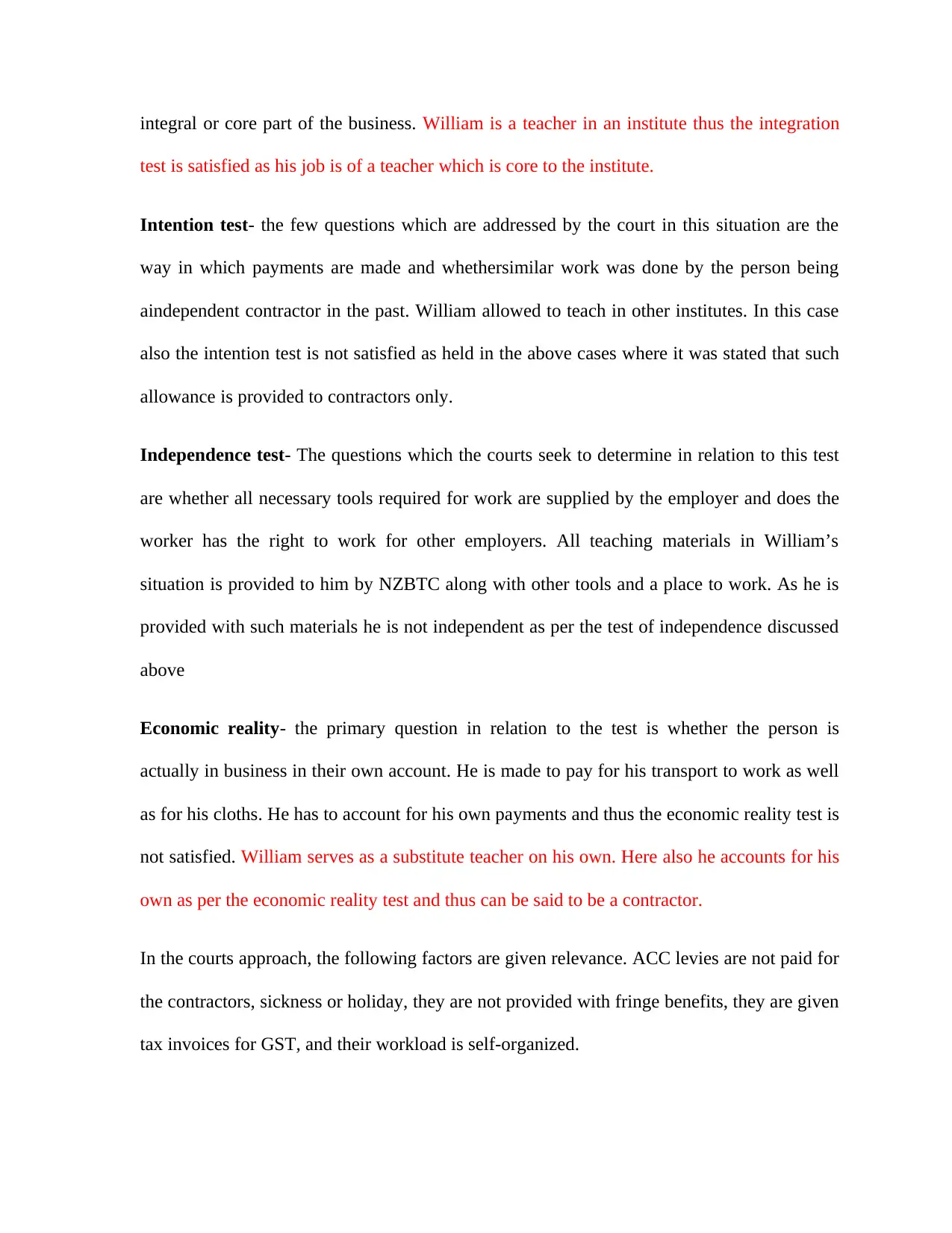
integral or core part of the business. William is a teacher in an institute thus the integration
test is satisfied as his job is of a teacher which is core to the institute.
Intention test- the few questions which are addressed by the court in this situation are the
way in which payments are made and whethersimilar work was done by the person being
aindependent contractor in the past. William allowed to teach in other institutes. In this case
also the intention test is not satisfied as held in the above cases where it was stated that such
allowance is provided to contractors only.
Independence test- The questions which the courts seek to determine in relation to this test
are whether all necessary tools required for work are supplied by the employer and does the
worker has the right to work for other employers. All teaching materials in William’s
situation is provided to him by NZBTC along with other tools and a place to work. As he is
provided with such materials he is not independent as per the test of independence discussed
above
Economic reality- the primary question in relation to the test is whether the person is
actually in business in their own account. He is made to pay for his transport to work as well
as for his cloths. He has to account for his own payments and thus the economic reality test is
not satisfied. William serves as a substitute teacher on his own. Here also he accounts for his
own as per the economic reality test and thus can be said to be a contractor.
In the courts approach, the following factors are given relevance. ACC levies are not paid for
the contractors, sickness or holiday, they are not provided with fringe benefits, they are given
tax invoices for GST, and their workload is self-organized.
test is satisfied as his job is of a teacher which is core to the institute.
Intention test- the few questions which are addressed by the court in this situation are the
way in which payments are made and whethersimilar work was done by the person being
aindependent contractor in the past. William allowed to teach in other institutes. In this case
also the intention test is not satisfied as held in the above cases where it was stated that such
allowance is provided to contractors only.
Independence test- The questions which the courts seek to determine in relation to this test
are whether all necessary tools required for work are supplied by the employer and does the
worker has the right to work for other employers. All teaching materials in William’s
situation is provided to him by NZBTC along with other tools and a place to work. As he is
provided with such materials he is not independent as per the test of independence discussed
above
Economic reality- the primary question in relation to the test is whether the person is
actually in business in their own account. He is made to pay for his transport to work as well
as for his cloths. He has to account for his own payments and thus the economic reality test is
not satisfied. William serves as a substitute teacher on his own. Here also he accounts for his
own as per the economic reality test and thus can be said to be a contractor.
In the courts approach, the following factors are given relevance. ACC levies are not paid for
the contractors, sickness or holiday, they are not provided with fringe benefits, they are given
tax invoices for GST, and their workload is self-organized.
⊘ This is a preview!⊘
Do you want full access?
Subscribe today to unlock all pages.

Trusted by 1+ million students worldwide
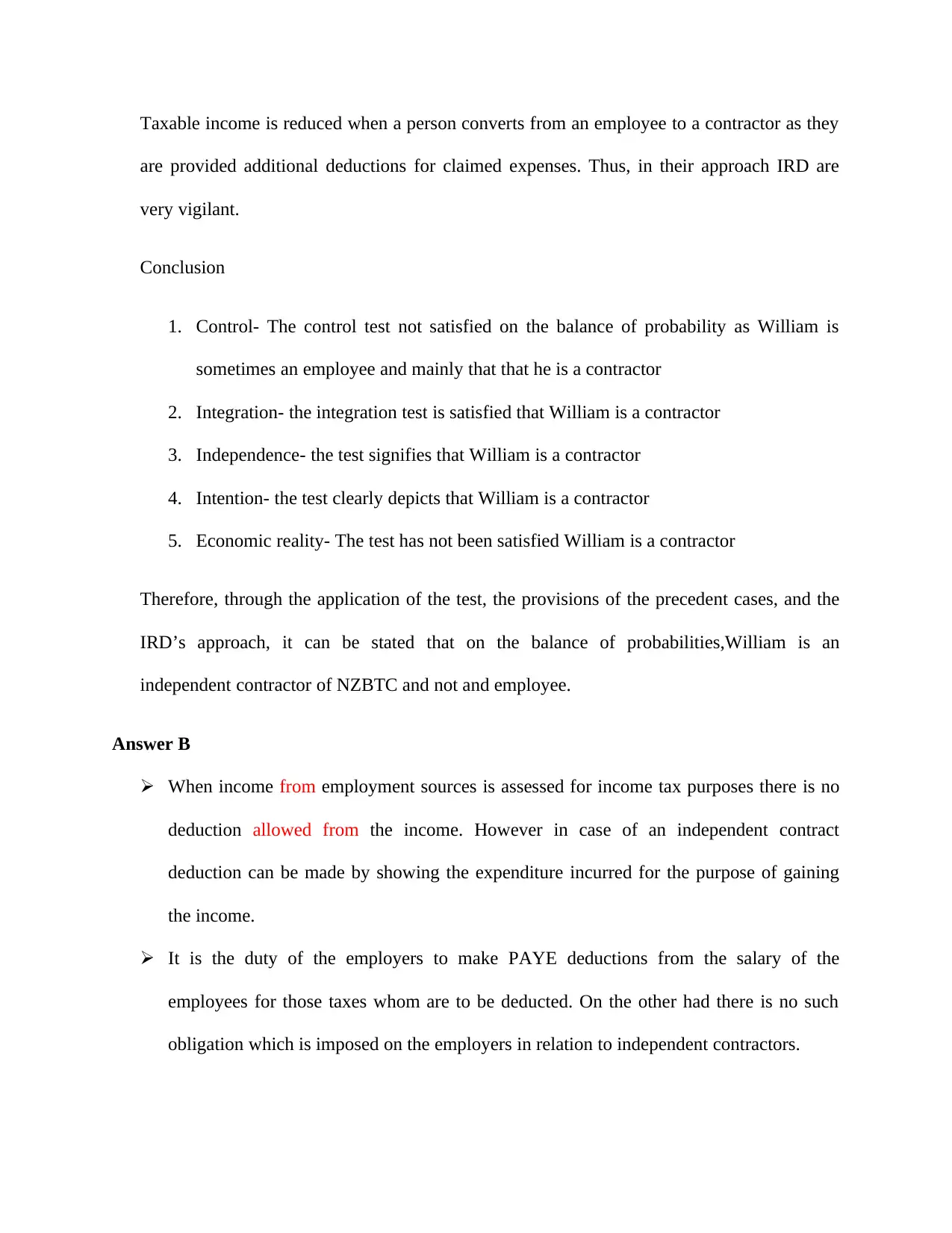
Taxable income is reduced when a person converts from an employee to a contractor as they
are provided additional deductions for claimed expenses. Thus, in their approach IRD are
very vigilant.
Conclusion
1. Control- The control test not satisfied on the balance of probability as William is
sometimes an employee and mainly that that he is a contractor
2. Integration- the integration test is satisfied that William is a contractor
3. Independence- the test signifies that William is a contractor
4. Intention- the test clearly depicts that William is a contractor
5. Economic reality- The test has not been satisfied William is a contractor
Therefore, through the application of the test, the provisions of the precedent cases, and the
IRD’s approach, it can be stated that on the balance of probabilities,William is an
independent contractor of NZBTC and not and employee.
Answer B
When income from employment sources is assessed for income tax purposes there is no
deduction allowed from the income. However in case of an independent contract
deduction can be made by showing the expenditure incurred for the purpose of gaining
the income.
It is the duty of the employers to make PAYE deductions from the salary of the
employees for those taxes whom are to be deducted. On the other had there is no such
obligation which is imposed on the employers in relation to independent contractors.
are provided additional deductions for claimed expenses. Thus, in their approach IRD are
very vigilant.
Conclusion
1. Control- The control test not satisfied on the balance of probability as William is
sometimes an employee and mainly that that he is a contractor
2. Integration- the integration test is satisfied that William is a contractor
3. Independence- the test signifies that William is a contractor
4. Intention- the test clearly depicts that William is a contractor
5. Economic reality- The test has not been satisfied William is a contractor
Therefore, through the application of the test, the provisions of the precedent cases, and the
IRD’s approach, it can be stated that on the balance of probabilities,William is an
independent contractor of NZBTC and not and employee.
Answer B
When income from employment sources is assessed for income tax purposes there is no
deduction allowed from the income. However in case of an independent contract
deduction can be made by showing the expenditure incurred for the purpose of gaining
the income.
It is the duty of the employers to make PAYE deductions from the salary of the
employees for those taxes whom are to be deducted. On the other had there is no such
obligation which is imposed on the employers in relation to independent contractors.
Paraphrase This Document
Need a fresh take? Get an instant paraphrase of this document with our AI Paraphraser

The employees are not required to register for GST as salary earners cannot claim GST in
relation to services related to the employment. On the other hand,independent contractors
have to register for GST where certain criteria are met.
Employees are not required to make payments for ACC levies. On the other hand, it is the
duty of the independent contractor to ensure that they pay ACC levies for themselves as
well as any of employees.
Question 2
Part A
Income
1. Under CW 62B of the Income Tax Act 2007 any income derived by a volunteer as a
reimbursement payment for the expenses gained by them is exempt income. Thus, this
income of Pam is exempt income (Legislation.govt.nz, 2018).
2. The income of $20,000 from a seldom lottery win will not be treated as a taxable income.
This is because in the case of (Reid v CIR, 1985) it had been ruled by the court that
“whether a receipt is an income depends on recurrence and regularity. Here the income is
a windfall gain.
3. The prize won by Dawn would be treated as an Income as it is a form of payment which
has been made in connection of the employment under section BC5 of the ITA
2007(Legislation.govt.nz, 2018).
4. The $30000 received by James would not be treated as an income as it would be treated
as a capital gain according to the provisions of(Eisner v Macomber , 1919). This is
relation to services related to the employment. On the other hand,independent contractors
have to register for GST where certain criteria are met.
Employees are not required to make payments for ACC levies. On the other hand, it is the
duty of the independent contractor to ensure that they pay ACC levies for themselves as
well as any of employees.
Question 2
Part A
Income
1. Under CW 62B of the Income Tax Act 2007 any income derived by a volunteer as a
reimbursement payment for the expenses gained by them is exempt income. Thus, this
income of Pam is exempt income (Legislation.govt.nz, 2018).
2. The income of $20,000 from a seldom lottery win will not be treated as a taxable income.
This is because in the case of (Reid v CIR, 1985) it had been ruled by the court that
“whether a receipt is an income depends on recurrence and regularity. Here the income is
a windfall gain.
3. The prize won by Dawn would be treated as an Income as it is a form of payment which
has been made in connection of the employment under section BC5 of the ITA
2007(Legislation.govt.nz, 2018).
4. The $30000 received by James would not be treated as an income as it would be treated
as a capital gain according to the provisions of(Eisner v Macomber , 1919). This is
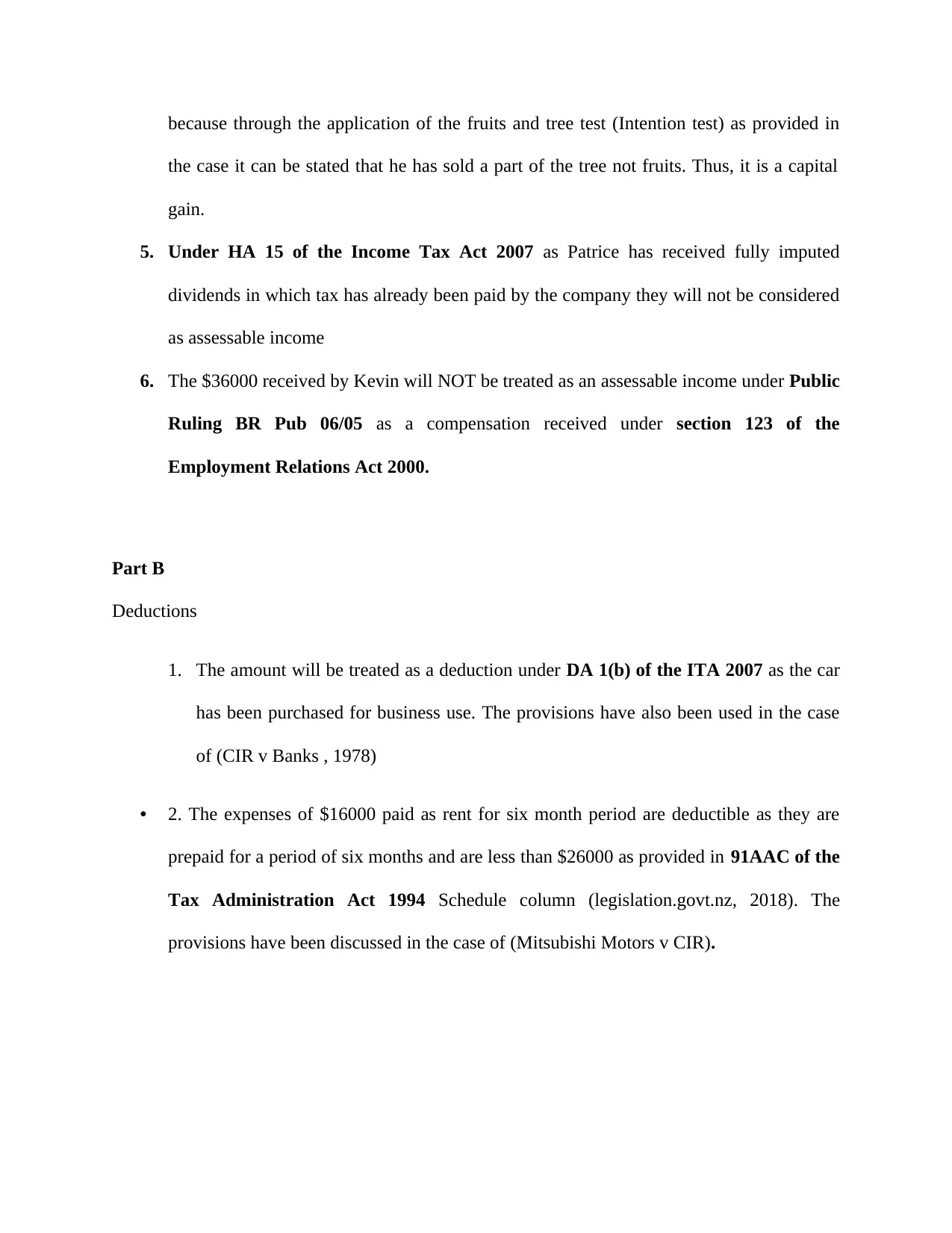
because through the application of the fruits and tree test (Intention test) as provided in
the case it can be stated that he has sold a part of the tree not fruits. Thus, it is a capital
gain.
5. Under HA 15 of the Income Tax Act 2007 as Patrice has received fully imputed
dividends in which tax has already been paid by the company they will not be considered
as assessable income
6. The $36000 received by Kevin will NOT be treated as an assessable income under Public
Ruling BR Pub 06/05 as a compensation received under section 123 of the
Employment Relations Act 2000.
Part B
Deductions
1. The amount will be treated as a deduction under DA 1(b) of the ITA 2007 as the car
has been purchased for business use. The provisions have also been used in the case
of (CIR v Banks , 1978)
• 2. The expenses of $16000 paid as rent for six month period are deductible as they are
prepaid for a period of six months and are less than $26000 as provided in 91AAC of the
Tax Administration Act 1994 Schedule column (legislation.govt.nz, 2018). The
provisions have been discussed in the case of (Mitsubishi Motors v CIR).
the case it can be stated that he has sold a part of the tree not fruits. Thus, it is a capital
gain.
5. Under HA 15 of the Income Tax Act 2007 as Patrice has received fully imputed
dividends in which tax has already been paid by the company they will not be considered
as assessable income
6. The $36000 received by Kevin will NOT be treated as an assessable income under Public
Ruling BR Pub 06/05 as a compensation received under section 123 of the
Employment Relations Act 2000.
Part B
Deductions
1. The amount will be treated as a deduction under DA 1(b) of the ITA 2007 as the car
has been purchased for business use. The provisions have also been used in the case
of (CIR v Banks , 1978)
• 2. The expenses of $16000 paid as rent for six month period are deductible as they are
prepaid for a period of six months and are less than $26000 as provided in 91AAC of the
Tax Administration Act 1994 Schedule column (legislation.govt.nz, 2018). The
provisions have been discussed in the case of (Mitsubishi Motors v CIR).
⊘ This is a preview!⊘
Do you want full access?
Subscribe today to unlock all pages.

Trusted by 1+ million students worldwide
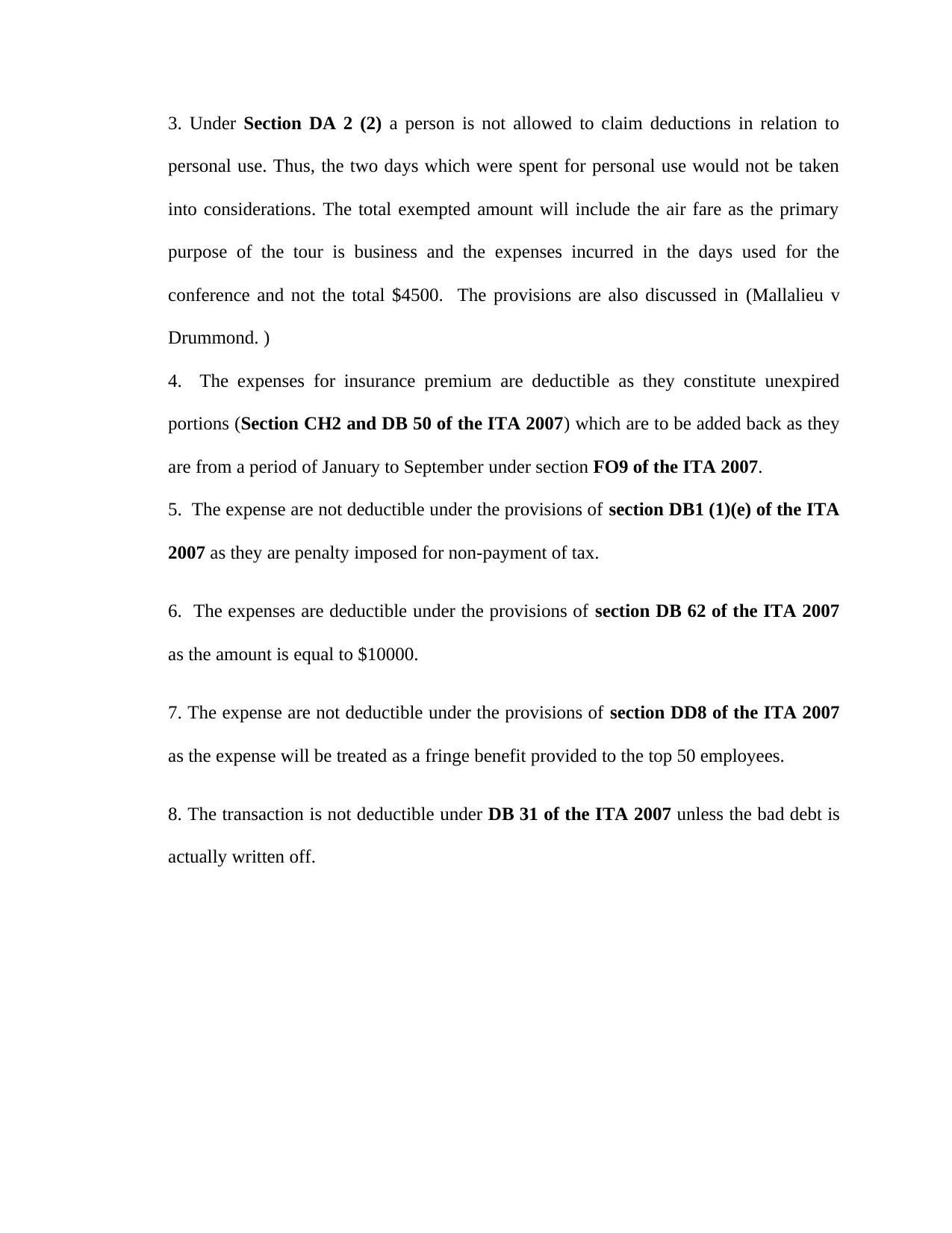
3. Under Section DA 2 (2) a person is not allowed to claim deductions in relation to
personal use. Thus, the two days which were spent for personal use would not be taken
into considerations. The total exempted amount will include the air fare as the primary
purpose of the tour is business and the expenses incurred in the days used for the
conference and not the total $4500. The provisions are also discussed in (Mallalieu v
Drummond. )
4. The expenses for insurance premium are deductible as they constitute unexpired
portions (Section CH2 and DB 50 of the ITA 2007) which are to be added back as they
are from a period of January to September under section FO9 of the ITA 2007.
5. The expense are not deductible under the provisions of section DB1 (1)(e) of the ITA
2007 as they are penalty imposed for non-payment of tax.
6. The expenses are deductible under the provisions of section DB 62 of the ITA 2007
as the amount is equal to $10000.
7. The expense are not deductible under the provisions of section DD8 of the ITA 2007
as the expense will be treated as a fringe benefit provided to the top 50 employees.
8. The transaction is not deductible under DB 31 of the ITA 2007 unless the bad debt is
actually written off.
personal use. Thus, the two days which were spent for personal use would not be taken
into considerations. The total exempted amount will include the air fare as the primary
purpose of the tour is business and the expenses incurred in the days used for the
conference and not the total $4500. The provisions are also discussed in (Mallalieu v
Drummond. )
4. The expenses for insurance premium are deductible as they constitute unexpired
portions (Section CH2 and DB 50 of the ITA 2007) which are to be added back as they
are from a period of January to September under section FO9 of the ITA 2007.
5. The expense are not deductible under the provisions of section DB1 (1)(e) of the ITA
2007 as they are penalty imposed for non-payment of tax.
6. The expenses are deductible under the provisions of section DB 62 of the ITA 2007
as the amount is equal to $10000.
7. The expense are not deductible under the provisions of section DD8 of the ITA 2007
as the expense will be treated as a fringe benefit provided to the top 50 employees.
8. The transaction is not deductible under DB 31 of the ITA 2007 unless the bad debt is
actually written off.
Paraphrase This Document
Need a fresh take? Get an instant paraphrase of this document with our AI Paraphraser

Bibliography
Bryson v Three Foot Six Limited (2005).
CIR v Banks , 61,236 (NZTC 1978).
Eisner v Macomber , 252 US 189 (1919).
Kiely, P. (2011). Independent contractor vs. employee. New Zealand Journal of Employment
Relations, 36(3), 58.
Legislation.govt.nz. (2018, March 3). Income Tax Act 2007. Retrieved from
www.legislation.govt.nz:
http://www.legislation.govt.nz/act/public/2007/0097/latest/DLM1517683.html#DLM151
7683
legislation.govt.nz. (2018, March 2). Tax Administration Act 1994. Retrieved from
legislation.govt.nz: www.legislation.govt.nz/act/public/1994/0166/350.0/contents.html
Mallalieu v Drummond. .
Mitsubishi Motors v CIR.
Reid v CIR, 7 NZTC 5,176 (1985).
TNT Worldwide Express (NZ) v Cunningham (1933).
Bryson v Three Foot Six Limited (2005).
CIR v Banks , 61,236 (NZTC 1978).
Eisner v Macomber , 252 US 189 (1919).
Kiely, P. (2011). Independent contractor vs. employee. New Zealand Journal of Employment
Relations, 36(3), 58.
Legislation.govt.nz. (2018, March 3). Income Tax Act 2007. Retrieved from
www.legislation.govt.nz:
http://www.legislation.govt.nz/act/public/2007/0097/latest/DLM1517683.html#DLM151
7683
legislation.govt.nz. (2018, March 2). Tax Administration Act 1994. Retrieved from
legislation.govt.nz: www.legislation.govt.nz/act/public/1994/0166/350.0/contents.html
Mallalieu v Drummond. .
Mitsubishi Motors v CIR.
Reid v CIR, 7 NZTC 5,176 (1985).
TNT Worldwide Express (NZ) v Cunningham (1933).
1 out of 8
Related Documents
Your All-in-One AI-Powered Toolkit for Academic Success.
+13062052269
info@desklib.com
Available 24*7 on WhatsApp / Email
![[object Object]](/_next/static/media/star-bottom.7253800d.svg)
Unlock your academic potential
Copyright © 2020–2025 A2Z Services. All Rights Reserved. Developed and managed by ZUCOL.




